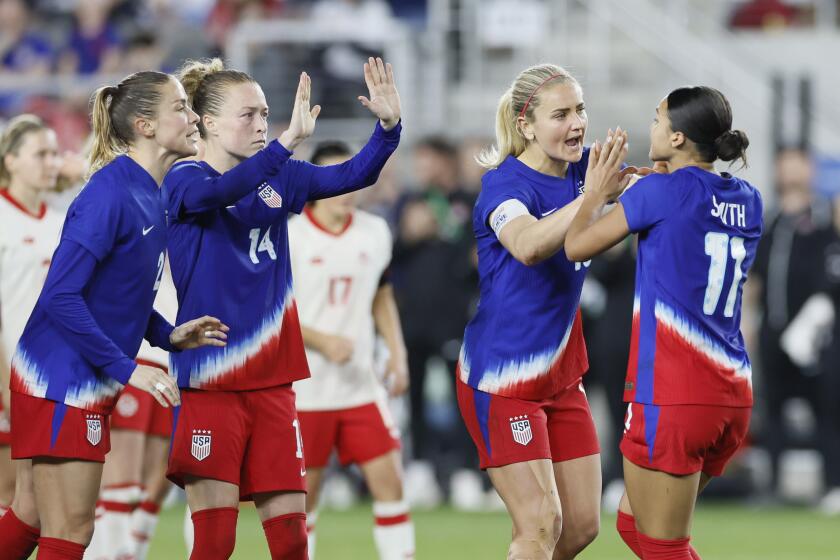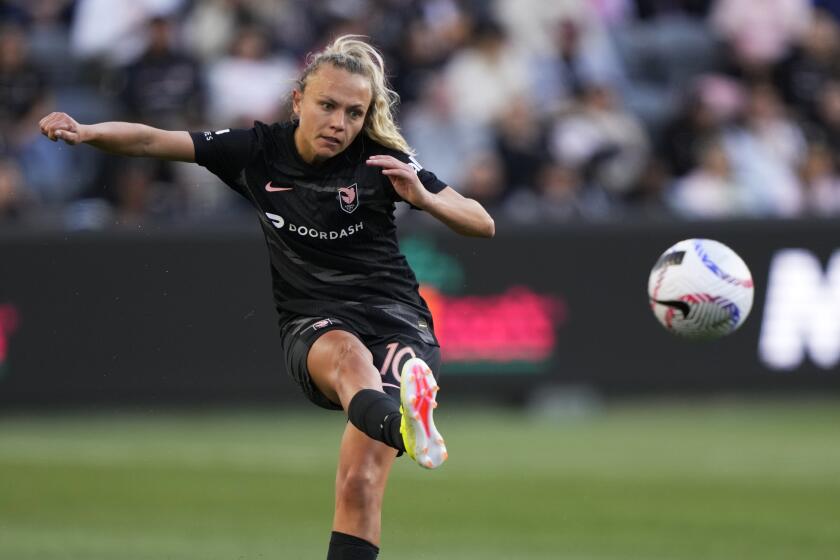American Dream Still Out of Reach
It is the players you feel for, the veterans who have spent a decade or two chasing an elusive dream, firm in the belief that one day, surely, soccer’s World Cup trophy would be held high by an American.
It will not come true in the near future.
That dream died here Thursday as the U.S. lost to Ghana 2-1, eliminating the American team from the World Cup, just as it died four years ago in South Korea, and four years before that in France.
As a nation we are still learning to play what Pele described as “the beautiful game.” Not beautifully. Not as well as others yet, true, but better than we once did. There was a 40-year gap between the U.S. appearance in the 1950 World Cup in Brazil and the 1990 World Cup in Italy.
It was a black hole, a lost generation.
But since 1990 the U.S. has qualified for the World Cup five times in a row and even reached the quarterfinals in 2002, spurring hope for this year’s team.
Had the U.S. won Thursday, it would have played world champion Brazil in the tournament’s second round. And that game, against the magical Brazilians, regardless of the result, would have edged soccer in the U.S. in the right direction -- closer to the sports it strives to match, closer to football, closer to baseball, closer to basketball, in public opinion.
The audience would have been huge, the interest immense.
Instead, the nation now turns its attention elsewhere. In the ESPN age there is always something else: the NBA draft comes next week, in July NFL training camps open, and baseball’s pennant races will soon heat up.
But soccer in the U.S. suffers from more than only a lack of public attention. Most of America’s best athletes continue to head for the NBA, Major League Baseball and the NFL where the financial rewards are far greater.
Another problem is that in the four-year cycle between World Cups, the U.S. team doesn’t play enough strong opponents in Europe, or in South America, against Brazil and Argentina. They tend to stay in their region and play Guatemala, Costa Rica and Panama, teams that are not good enough to raise the level of their competition.
Fortunately, the American soccer dream constantly reinvents itself, springing up with each season, when youngsters from New Jersey, just like Claudio Reyna, or from North Carolina, just like Eddie Pope, or from Illinois, just like Brian McBride, first step onto a soccer field.
And so you feel for the likes of Reyna, Pope and McBride, who have pursued the dream honestly and to the best of their ability for a dozen years and three World Cups.
They have gone through the countless training camps, the sacrifices it takes to keep their bodies in shape, the endless drudgery of air travel, the tricky qualifying games in not so fan-friendly places as Mazatenango, Guatemala; San Pedro Sula, Honduras; St. George’s, Grenada; and San Jose, Costa Rica.
The U.S. team, whether under coach Bob Gansler in 1990, Bora Milutinovic in 1994, Steve Sampson in 1998 and Bruce Arena in 2002 and 2006, has always tried to foster a positive relationship with its fans and the media. The players are accessible and outgoing. They are ambassadors. For the sport. For the future.
Today, that future looks murky again. Arena is mulling other options. Some players have announced their retirement. The younger generation is disappointed by the team’s first-round exit from Germany ’06.
This time the dream dissolved at the feet of a Ghana team flying its own colors and those of all Africa. It died because of a questionable refereeing decision, because of injury to the most influential American player and because, in the end, the Ghanaians simply were the better side.
True soccer fans will remain fixed in front of their television sets for the rest of the World Cup, but fans who are wrapped only in the flag will move on. For them, the inglorious exit of the Americans signaled the time to leave.
That’s too bad, because only by following soccer at its very highest level can Americans ever appreciate the game’s artistry, its subtle nuances, its raw athletic energy.
Watch the Brazilians, the Argentines and the Dutch in full flow in 2006 and you cannot help but come away with the realization that this is a sport that matches the beauty Pele once described. That is progress, and if right now soccer in the U.S. takes a step back to move two steps forward, then so be it.
In two years’ time, the U.S. once again will set out on a World Cup qualifying quest. Players not yet well known to fans will be wearing the red, white and blue. They will run where Reyna, Pope and McBride once ran.
Like them, they will dream the dream and believe.
South Africa 2010. It’s not that far away.
*
Grahame L. Jones has covered soccer for The Times for the last 30 years and has reported on every World Cup since 1982.






